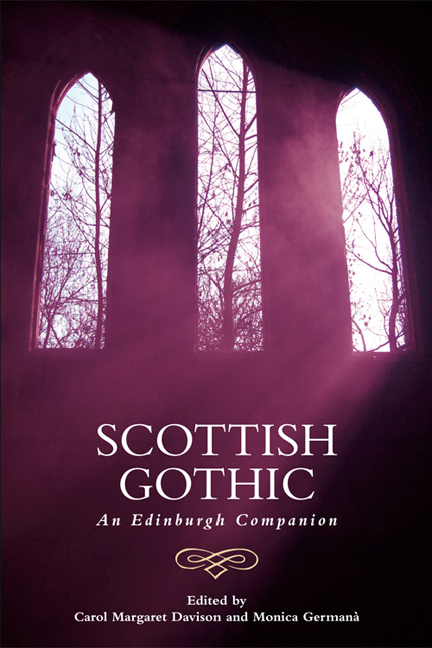Book contents
- Frontmatter
- Contents
- Acknowledgements
- 1 Borderlands of Identity and the Aesthetics of Disjuncture: An Introduction to Scottish Gothic
- 2 ‘The Celtic Century’ and the Genesis of Scottish Gothic
- 3 The Politics and Poetics of the ‘Scottish Gothic’ from Ossian to Otranto and Beyond
- 4 Robert Burns and the Scottish Bawdy Politic
- 5 Scottish Gothic Drama
- 6 Scottish Gothic Poetry
- 7 Calvinist and Covenanter Gothic
- 8 Gothic Scott
- 9 Gothic Hogg
- 10 ‘The Singular Wrought Out into the Strange and Mystical’: Blackwood's Edinburgh Magazine and the Transformation of Terror
- 11 Gothic Stevenson
- 12 J. M. Barrie's Gothic: Ghosts, Fairy Tales and Lost Children
- 13 The ‘nouveau frisson’: Muriel Spark's Gothic Fiction
- 14 Scottish Gothic and the Moving Image: A Tale of Two Traditions
- 15 New Frankensteins; or, the Body Politic
- 16 Queer Scottish Gothic
- 17 Authorship, ‘Ghost-filled’ Islands and the Haunting Feminine: Contemporary Scottish Female Gothic
- Notes on Contributors
- Index
14 - Scottish Gothic and the Moving Image: A Tale of Two Traditions
Published online by Cambridge University Press: 20 December 2017
- Frontmatter
- Contents
- Acknowledgements
- 1 Borderlands of Identity and the Aesthetics of Disjuncture: An Introduction to Scottish Gothic
- 2 ‘The Celtic Century’ and the Genesis of Scottish Gothic
- 3 The Politics and Poetics of the ‘Scottish Gothic’ from Ossian to Otranto and Beyond
- 4 Robert Burns and the Scottish Bawdy Politic
- 5 Scottish Gothic Drama
- 6 Scottish Gothic Poetry
- 7 Calvinist and Covenanter Gothic
- 8 Gothic Scott
- 9 Gothic Hogg
- 10 ‘The Singular Wrought Out into the Strange and Mystical’: Blackwood's Edinburgh Magazine and the Transformation of Terror
- 11 Gothic Stevenson
- 12 J. M. Barrie's Gothic: Ghosts, Fairy Tales and Lost Children
- 13 The ‘nouveau frisson’: Muriel Spark's Gothic Fiction
- 14 Scottish Gothic and the Moving Image: A Tale of Two Traditions
- 15 New Frankensteins; or, the Body Politic
- 16 Queer Scottish Gothic
- 17 Authorship, ‘Ghost-filled’ Islands and the Haunting Feminine: Contemporary Scottish Female Gothic
- Notes on Contributors
- Index
Summary
Introduction
The Gothic has long been acknowledged as a significant cultural influence within Britain's cinematic heritage. In his seminal study of ‘the English Gothic cinema’, David Pirie asserts:
It certainly seems to be arguable on commercial, historical and artistic grounds that the horror genre, as it has been developed in this country by Hammer and its rivals, remains the only staple cinematic myth which Britain can properly claim as its own, and which relates to it in the same way as the western relates to America.
(Pirie 1973: 9)Locating the roots of the British contribution to cinematic horror in the familiar literary terrain of classic Gothic fiction initiated in the late eighteenth century by Horace Walpole, Ann Radcliffe and M. G. Lewis, Pirie makes a persuasive case for the value of the genre and its centrality to the cultural specificity of a (then critically undervalued) ‘national’ cinema. But what is immediately striking from a contemporary, post-devolutionary vantage point is the Anglocentrism of the analysis as conveyed by the interchangeable use of the terms ‘English’ and ‘British’ throughout his book. Moreover, while acknowledging that ‘the role of Ireland in Gothic literature is immense’ (1973: 96), Pirie proceeds to co-opt C. R. Maturin's Melmoth the Wanderer (1820) – for him a foundational text alongside Lewis's The Monk (1796) – to a singularly English literary tradition. But just as Maturin's novel is now regarded as an exemplar of a distinctive tradition of Irish Gothic (Punter 2002: 105), so in this chapter I want to move beyond the limitations of Pirie's conceptual framework to consider the significance of the Gothic to Scottish cinema. This also necessarily transcends the confines of the horror genre to consider wider reverberations of a particular cultural sensibility or structure of feeling.
The cinematic representation of Scotland, its landscapes and inhabitants has benefited greatly from an increase in local production from the early 1980s onwards, stimulated by new sources of funding and creating the idea of a small national cinema connected to yet also distinct from a London-centric British film industry (Petrie 2000). This also brought about a shift of focus away from a vision of Scotland as a rural, remote and timeless place informed by romantic fantasy, towards a new engagement with the urban, the contemporary and the social, much of it rendered through the aesthetics of realism.
- Type
- Chapter
- Information
- Scottish GothicAn Edinburgh Companion, pp. 181 - 194Publisher: Edinburgh University PressPrint publication year: 2017



